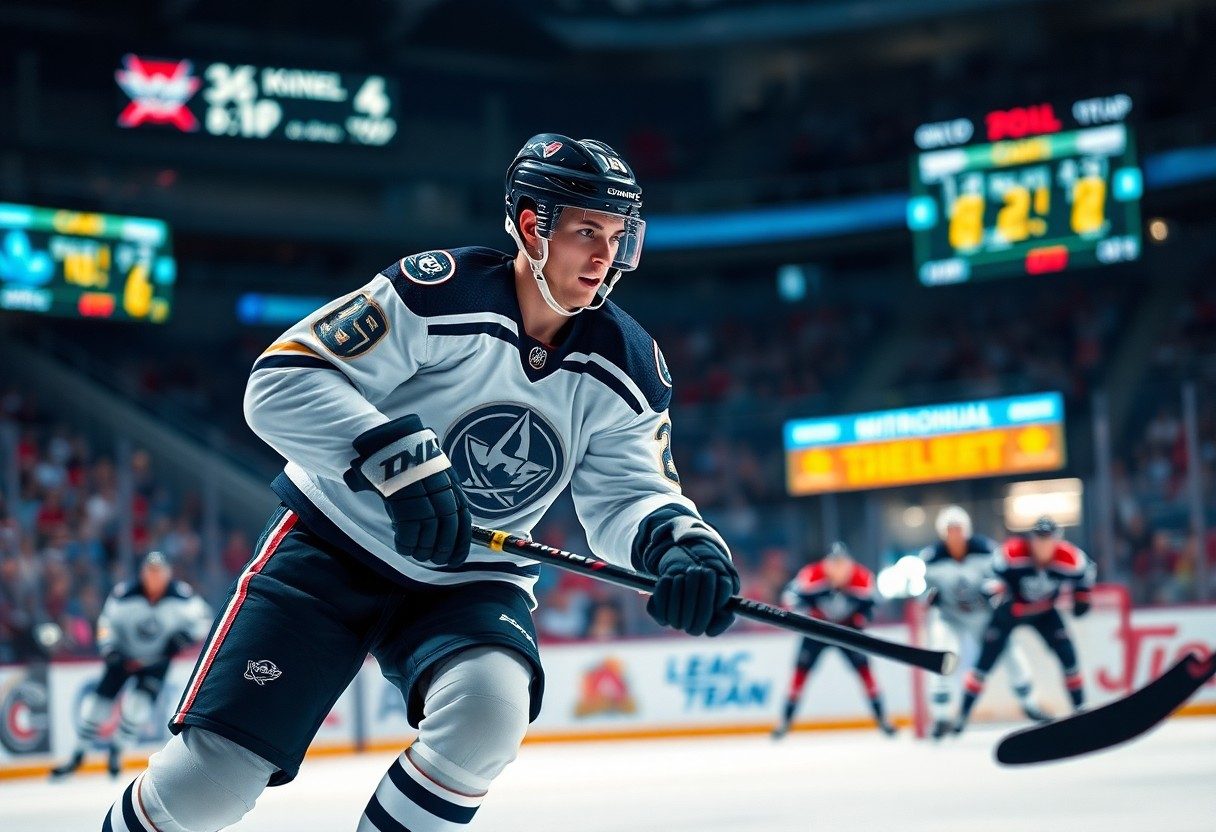Over the decades, the landscape of the NHL has transformed dramatically, reshaping how players develop their skills, enhance their speed, and implement strategies on the ice. This evolution reflects not just advancements in training methods and technology, but also shifting game dynamics that prioritize agility and teamwork. Understanding these changes is imperative for fans and aspiring players alike, as today’s athletes leverage a blend of athleticism and tactical acumen to thrive in an increasingly competitive environment.
Types of Modern NHL Players
Modern NHL players can be categorized into distinct types, each contributing uniquely to their teams. These classifications help clarify the roles players undertake during games, underscoring the diversity of skills present in today’s league.
- Offensive Players
- Defensive Players
- Two-Way Players
- Enforcers
- Goaltenders
| Type | Description |
|---|---|
| Offensive Players | Focus primarily on scoring and playmaking. |
| Defensive Players | Specialize in blocking shots and aiding goaltenders. |
| Two-Way Players | Contribute to both defensive and offensive plays. |
| Enforcers | Protect teammates through physical play. |
| Goaltenders | Key for stopping the puck and dictating defensive strategies. |
Offensive Players
Offensive players are the stars of the ice, often leading their teams in goals and assists. With exemplary skills in skating and stickhandling, they create opportunities and put pressure on the opposing defense. Players like Connor McDavid and Alex Ovechkin exemplify this role through their superior vision and precise shooting abilities. The focus on offensive prowess has significantly increased the excitement of the game, making these players crucial for team success.
Defensive Players
Defensive players are vital for maintaining team structure and protecting the net. Their primary responsibility is to block shots, check opponents, and clear pucks from danger zones. Players such as Victor Hedman and Drew Doughty excel at anticipating plays and executing crucial defensive maneuvers. The role encompasses not just physicality, but also an understanding of strategic positioning. The evolution of defensive play has affected game strategies, making it more challenging for offensive players.
Modern defensive players combine traditional skills with speed and agility. They now also contribute offensively, showcasing their ability to join rushes and support breakout plays. Historically seen as the backbone of the team’s defense, they are now instrumental in transitioning from defense to offense, with many possessing strong passing abilities. This dual capability has altered how teams view defensive roles, integrating them more deeply into overall team strategy.
Goaltenders
Goaltenders are the last line of defense and play a critical role in a team’s success. Their ability to make split-second decisions and execute precise movements can determine the outcome of games. Top-tier goaltenders like Andrei Vasilevskiy and Igor Shesterkin showcase remarkable reflexes and positioning that are crucial in the fast-paced NHL environment. The emphasis on goaltending has evolved, with many teams investing heavily in training techniques and technologies to enhance their skills.
The modern goaltender’s role has shifted with the advent of advanced analytics and techniques. They now utilize innovative training regimens focusing on reaction time and situational awareness. The combination of athleticism and mental fortitude is imperative for thriving in today’s high-octane games. Additionally, the introduction of the butterfly style has revolutionized goaltending, enabling ultimate puck coverage and maximizing save potential.
Essential Skills for Success
Success in the NHL hinges on a blend of imperative skills that allow players to excel in a fast-paced and highly competitive environment. Mastery of these skills not only enhances individual performance but also strengthens overall team dynamics. From skating speed to puck control, each element plays a significant role in the modern player’s effectiveness on the ice.
Skating and Speed
Skating is the foundation of an NHL player’s game, with speed being a critical component. Players like Connor McDavid exemplify this with their ability to reach speeds of up to 40 kilometers per hour, enabling quick transitions and breakaways. Efficient skating mechanics, including quick strides and agility, directly impact a player’s ability to navigate through defenders and create scoring opportunities.
Shooting and Puck Control
Shooting and puck control are paramount for scoring and maintaining possession. A player must refine their shooting techniques, including wrist shots, slap shots, and backhand attempts, to effectively find the back of the net. Top-tier players demonstrate incredible puck control with quick stick handling, allowing them to maneuver under pressure and create plays that can change the course of a game.
Examples such as Alex Ovechkin’s prolific slap shot highlight the importance of precision and power, often resulting in goals from impossible angles. Furthermore, players like Patrick Kane showcase exceptional puck control, effortlessly combining skating with intricate stick handling to navigate through defenses. These abilities are complemented by rigorous training and drills tailored to enhance accuracy and reaction time.
Tactical Awareness
Tactical awareness is vital for modern NHL players, involving a deep understanding of game strategy and positions. Players who excel in this area can anticipate opponents’ movements and read plays effectively, making split-second decisions that can lead to advantageous situations.
The ability to adapt to changing circumstances on the ice is what sets elite players apart. For instance, players like Sidney Crosby are known for their exceptional vision and understanding of spatial dynamics, allowing them to outthink their opponents. This heightened awareness fosters a player’s capacity to predict passes, set up teammates, and exploit defensive weaknesses, ultimately influencing the game’s outcome. By mastering tactical awareness, players not only enhance their individual performance but also contribute significantly to their team’s success in tight matchups.
Speed as a Game Changer
In the fast-paced world of the NHL, speed has emerged as a definitive edge, revolutionizing how games are played. Teams that prioritize speed can create higher scoring opportunities and disrupt the opposition’s strategies. Players known for their quick bursts can change the dynamics on the ice, making them vital assets in both offensive and defensive play. The shift towards a faster game has led to an evolution in player recruitment, with scouts now placing a premium on skating ability and reaction times.
Importance of Acceleration
Acceleration is a key component of a player’s speed, allowing them to reach top velocity in a matter of strides. This explosiveness is vital, especially during breakaways or when maneuvering past defenders. NHL players often train meticulously to enhance their first few strides, which can be the difference between a scoring chance and a missed opportunity. Enhanced acceleration also aids in defensive play, enabling quick recoveries and positioning.
Training for Speed
Training for speed encompasses a variety of techniques aimed at improving both strength and agility. Players engage in specialized drills, incorporating sprinting, plyometrics, and resistance training to build explosive power. On-ice drills are also tailored to include rapid directional changes, simulating game scenarios that require quick acceleration. This dynamic approach ensures players refine their speed effectively.
Focus on strength training often includes lower body exercises like squats and deadlifts, which contribute to powerful strides. Agility ladders and cone drills further develop foot speed and reaction time. By implementing a combination of on-ice and off-ice training regimens, players can maximize their potential, leading not only to improved personal performance but also enhancing overall team efficiency during games.
Impact on Game Strategy
The emphasis on speed has significantly influenced game strategy, with teams increasingly utilizing tactics that capitalize on fast movement. Breakout plays and transitional offense have become staples, requiring quick passes and swift player movements to maintain tempo. Defensively, teams are adjusting their structure to manage the fast-paced gameplay effectively, often emphasizing a tighter formation.
Coaches increasingly design systems that favor quick transitions from defense to offense, urging players to exploit openings created through swift skating. High-pressure systems aim to force opponents into mistakes with aggressive forechecking, while offensive formations might prioritize speed through the neutral zone to capitalize on defensive lapses. This strategic shift not only enhances the excitement of games but also demands greater adaptability from players, reinforcing the vital role of speed in modern hockey.
Strategic Play in the NHL
The modern NHL player thrives within a framework of intricate strategies that dictate how teams operate on the ice. These strategies hinge on a deep understanding of game dynamics, allowing players to make effective decisions that enhance their competitive edge. Each play is meticulously designed to exploit opponent weaknesses while capitalizing on the unique strengths of the team, demonstrating that strategy is as vital as raw talent in today’s game.
Understanding Team Strategies
Team strategies in the NHL incorporate specific formations, systems, and plays that align with the strengths of their roster. Concepts such as the forecheck and power play are tailored to maximize offensive opportunities while minimizing defensive risks. For example, a team may implement a 1-2-2 forecheck to disrupt opponent breakouts, forcing turnovers in the offensive zone.
Adapting to Opponents
Successful NHL teams excel in adapting their strategies based on the unique attributes of their opponents. Players must assess the strengths and weaknesses of rival teams, adjusting their play styles to exploit gaps or counter threats effectively. This adaptability can be the difference between victory and defeat in a critical matchup.
Adapting to opponents involves studying their previous games, recognizing patterns in play, and making real-time adjustments during matches. For instance, a team might switch from a defensive posture to an aggressive forechecking style if they determine their opponent struggles against high-pressure situations. This level of adaptability requires players to be quick thinkers and versatile in executing multiple strategies seamlessly, demonstrating the importance of preparation and situational awareness in the fast-paced environment of the NHL.
The Role of Coaches
Coaches play a pivotal role in shaping team strategies and ensuring that players are equipped to execute them effectively. They analyze game footage, develop playbooks, and create specialized drills aimed at enhancing players’ tactical understanding. A coach’s insight can provide the tactical nuances that elevate a team’s performance on a nightly basis.
The insight and guidance provided by coaches are instrumental in fostering a culture of strategic play within a team. A seasoned coach, like John Tortorella, emphasizes discipline and accountability, instilling in players the need to be adaptable and responsive during games. Coaches also oversee adjustments made during intermissions, often making decisive calls that can turn the tide of a game. Their ability to read the flow of play and suggest tactical shifts enhances the team’s resilience and competitiveness, showcasing the deep impact of coaching on strategic success in the NHL.
Factors Influencing Player Evolution
Multiple factors contribute to the evolution of NHL players, shaping their development and performance on the ice. Key influences include:
- Advances in Training Techniques
- Nutrition and Fitness
- Technology’s Role
Thou cannot underestimate how these elements interplay to enhance player capabilities.
Advances in Training Techniques
Modern NHL players benefit from innovative training techniques focused on maximizing performance, injury prevention, and overall athleticism. Sophisticated conditioning regimens, including specialized drills and mental resilience training, have refined how players prepare for the demands of the game.
Nutrition and Fitness
Player nutrition and fitness regimes have become increasingly specialized, emphasizing macronutrient balance and overall wellness. Athletes now consult with nutritionists to fine-tune their diets, ensuring optimal performance and recovery.
The shift towards personalized nutrition plans has enabled players to enhance their energy levels while minimizing body fat. For instance, the emphasis on protein-rich diets, hydration strategies, and post-game recovery nutrition ensures that athletes maintain high performance during the grueling NHL season. Special attention is given to meal timing and the quality of ingredients, setting a new standard for what it means to be a professional hockey player.
Technology’s Role
Technology plays a pivotal role in the ongoing evolution of NHL players, influencing training methodologies and game performance analysis. Tools such as wearable devices and video analysis software provide real-time feedback to athletes and coaches.
Advancements like AI-driven analytics and performance tracking systems help refine training programs and game strategies. For instance, players can analyze their skating efficiency, shot accuracy, and even recovery patterns using these sophisticated technologies. This data-driven approach enables personalized training regimens tailored to an individual player’s strengths and weaknesses, allowing for continuous development in an era where performance metrics are paramount.
Pros and Cons of Modern Gameplay
| Pros | Cons |
|---|---|
| Increased scoring opportunities | Higher injury rates |
| Faster pace generates excitement | Less emphasis on physical play |
| Enhanced skills development | Shorter player careers |
| Strategies evolve with analytics | Over-reliance on speed tactics |
| Global talent pool expansion | Increased pressure on young players |
| Greater fan engagement | Simplification of game strategies |
| More focus on teamwork and cooperation | Increased player fatigue |
| Improved overall athleticism | Less time for player development |
| Statistical innovations | Potential burnout among players |
| Dynamic broadcasting and media coverage | Risk of diminishing traditional skills |
Advantages of Increased Speed
The increased speed in modern NHL gameplay leads to more dynamic and entertaining matches. Faster skaters and rapid puck movement create a thrilling atmosphere that captivates fans. Teams focusing on speed often capitalize on quick transitions, enabling them to counterattack efficiently and create scoring chances. Players consistently adopt training regimens to enhance agility, further perpetuating this high-speed evolution.
Drawbacks of the Fast-Paced Game
While speed enhances excitement, there are notable drawbacks. The emphasis on rapid play often results in increased injury rates due to collisions and fatigue. Players may also struggle with the mental and physical demands of such a fast-paced environment, which can lead to burnout and decreased performance over time.
This fast-paced nature of the game necessitates that players operate at peak performance levels, leaving little room for mistakes. Injuries like concussions, muscle strains, and soft tissue injuries become prevalent as players push their limits. As the game prioritizes speed and finesse over a physical style, less enduring intensive gameplay can result in players experiencing higher wear and tear on their bodies, ultimately affecting their longevity in the sport.
Impact on Player Longevity
The demand for speed within the game significantly influences player longevity. Athletes are now required to continuously adapt to the fast-paced nature, which often leads to physical and mental strain. As players age or sustain injuries, their ability to keep up with younger, quicker competitors can diminish, resulting in shorter careers. A shift towards more tactical training focused on agility also impacts how players manage their bodies over time.
This fast-paced environment presents challenges for maintaining player health, as constant acceleration and rapid changes of direction increase the risk of injury. Athletes are compelled to invest more in recovery protocols and fitness regimens, leaving them vulnerable to accelerated aging. Consequently, many players find themselves retiring earlier, struggling to maintain the pace as the league evolves and young talent emerges. As the game prioritizes speed, finding a balance between performance demands and player welfare becomes increasingly imperative.
To wrap up
Upon reflecting, the evolution of the modern NHL player showcases a transformative blend of enhanced skills, increased speed, and strategic gameplay. As training methods and technology advance, players are not only more athletic but also exhibit a deeper understanding of the game. This shift highlights a generation that prioritizes adaptability and intelligence on the ice, reshaping how the sport is played and perceived. The future of the NHL promises even greater developments, making it imperative to appreciate the ongoing changes that define the modern athlete.
FAQ
Q: How has the skill set of NHL players evolved over the years?
A: The skill set of NHL players has significantly evolved, with an increased emphasis on puck handling, shooting accuracy, and strategic playmaking. Modern players are more versatile, often proficient in multiple positions, and excel in both offensive and defensive roles. Additionally, training methods have advanced, leading to improved physical conditioning and injury prevention techniques.
Q: What impact has speed had on the modern NHL game?
A: Speed has become a defining characteristic of the modern NHL, influencing the pace and style of the game. Players are generally faster, which allows for quicker transitions between offense and defense. The emphasis on speed has changed coaching strategies, focusing on fast breakouts and maintaining a high tempo to outpace opponents. Teams often prioritize agile skaters to exploit this advantage.
Q: How have strategies changed in the NHL due to player evolution?
A: Strategies in the NHL have adapted to the evolving skill set of players, incorporating more dynamic game plans. Teams utilize advanced analytics to inform their strategies, optimizing line combinations and matchups. The focus has shifted towards creating scoring opportunities through speed and skill, employing tactics such as zone entries and forechecking systems that capitalize on the players’ enhanced abilities.












